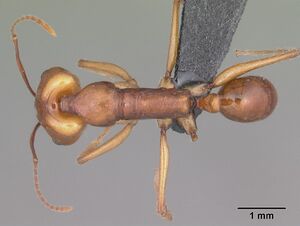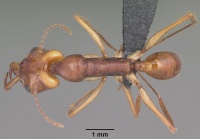Anochetus goodmani
| Anochetus goodmani | |
|---|---|

| |
| Scientific classification | |
| Kingdom: | Animalia |
| Phylum: | Arthropoda |
| Class: | Insecta |
| Order: | Hymenoptera |
| Family: | Formicidae |
| Subfamily: | Ponerinae |
| Tribe: | Ponerini |
| Genus: | Anochetus |
| Species: | A. goodmani |
| Binomial name | |
| Anochetus goodmani Fisher, 2008 | |
Collected in dry forest and rainforest as low as 30 m in altitude and also in montane rainforest at the altitude 960 m on Montagne d'Ambre, most frequently under stones (12 collections) and sifted litter (7), but also at light (1), beating low vegetation (3), rot pocket (1), in rotten log (6), ground foragers (1), ground nest (9), Malaise trap (1), on low vegetation (1), and pitfall traps (4).
Identification
The species is most similar to Anochetus boltoni but can be easily distinguished by its petiole node without apical spines (Fisher and Smith 2008).
Keys including this Species
Distribution
Endemic to Madagascar and is widespread in northern and western parts of the island.
Latitudinal Distribution Pattern
Latitudinal Range: -13.255° to -13.255°.
| North Temperate |
North Subtropical |
Tropical | South Subtropical |
South Temperate |
- Source: AntMaps
Distribution based on Regional Taxon Lists
Malagasy Region: Madagascar (type locality).
Distribution based on AntMaps
Distribution based on AntWeb specimens
Check data from AntWeb
Countries Occupied
| Number of countries occupied by this species based on AntWiki Regional Taxon Lists. In general, fewer countries occupied indicates a narrower range, while more countries indicates a more widespread species. |

|
Estimated Abundance
| Relative abundance based on number of AntMaps records per species (this species within the purple bar). Fewer records (to the left) indicates a less abundant/encountered species while more records (to the right) indicates more abundant/encountered species. |

|
Biology
|
Castes
No winged queens are known. Ergatoid queens were collected at six localities. In four of the collections, three ergatoid queens were collected in the same locality. They are very similar in size and shape to workers, and have no ocelli. Males are not known. (Fisher and Smith 2008)
Worker
Images from AntWeb
   
| |
| Paratype of Anochetus goodmani. Worker. Specimen code casent0104548. Photographer April Nobile, uploaded by California Academy of Sciences. | Owned by CAS, San Francisco, CA, USA. |
   
| |
| Worker. Specimen code casent0416368. Photographer April Nobile, uploaded by California Academy of Sciences. | Owned by CAS, San Francisco, CA, USA. |
   
| |
| Queen (ergatoid). Specimen code casent0454531. Photographer April Nobile, uploaded by California Academy of Sciences. | Owned by CAS, San Francisco, CA, USA. |
    
| |
| Holotype of Anochetus goodmani. Worker. Specimen code casent0498309. Photographer April Nobile, uploaded by California Academy of Sciences. | Owned by CAS, San Francisco, CA, USA. |

| |
| Worker. Specimen code casent0104543. Photographer April Nobile, uploaded by California Academy of Sciences. | Owned by CAS, San Francisco, CA, USA. |
Nomenclature
The following information is derived from Barry Bolton's Online Catalogue of the Ants of the World.
- goodmani. Anochetus goodmani Fisher, in Fisher & Smith, 2008: 6, figs. 2e-h (w.q.) MADAGASCAR.
- Type-material: holotype worker, 8 paratype workers.
- Type-locality: holotype Madagascar: Forêt de Binara, 7.5 km. 230° SW Daraina, 13°15’18’’S, 49°37’00’’E, 375 m., 1-4.xii.2003, BLF09638 (B.L. Fisher, et al.); paratypes with same data.
- Type-depositories: CASC (holotype); BMNH, CASC, MCZC (paratypes).
- Distribution: Madagascar.
Unless otherwise noted the text for the remainder of this section is reported from the publication that includes the original description.
Description
Worker
Measurements: maximum and minimum based on all specimens, n = 15, (holotype): HL 1.77–2.01 (1.92), HW 1.55–1.81 (1.77), CI 86–92 (92), EL 0.35–0.43 (0.42), ML 1.04–1.15 (1.11), MI 56–66 (58), SL 1.68–1.97 (1.79) SI 101–109 (101), WL 2.52–2.89 (2.66), FL 1.85–2.17 (2.03), PW 0.92–1.06 (1.01).
Blade of mandible with five teeth and denticles located at the distal half of the blade length. Petiole dorsal margin without spines. In front view, the dorsal petiolar margin flat with lateral margin rounded.
Queen
(ergatoid) measurements: maximum and minimum based on n = 5. HL 1.62–1.79, HW 1.49–1.65, CI 91–93, EL 0.37–0.41, ML 0.92–1.02, MI 55–59, SL 1.56–1.71, SI 99–106, WL 2.33–2.55, FL 1.77–1.91, PW 0.88–0.99.
Type Material
Holotype worker, MADAGASCAR, Forêt de Binara, 7.5 km 230° SW Daraina, 13°15′18″S, 049°37′00″E, 375 m, 1–4 Dec 2003 (coll. B. L. Fisher et al.), CASENT0498309 (California Academy of Sciences). Paratypes: 8 workers with same data as holotype but pins coded, CASENT104548, CASENT0498310, CASENT0498311, CASENT0006944, CASENT0006945 (The Natural History Museum, Museum of Comparative Zoology, CASC); CO1 Barcode from paratype collection and coded CASENT0498310-D01.
References
- Fisher, B. L. and M. A. Smith. 2008. A Revision of Malagasy Species of Anochetus Mayr and Odontomachus Latreille (Hymenoptera: Formicidae). PloS one. 3:e1787.
References based on Global Ant Biodiversity Informatics
- Fisher B. L., and M. A. Smith. 2008. A revision of Malagasy species of Anochetus Mayr and Odontomachus Latreille (Hymenoptera: Formicidae). PLoS ONE 3(5): e1787. doi:10.1371/journal.pone.0001787

